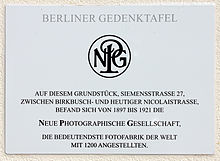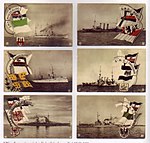New Photographic Society
The New Photographic mbH (NPG) was a German company which was from 1894 to 1948. It developed the NPG pigment process , simplified the mass production of photographs and is considered to be the inventor of "kilometer photography". Instead of individual sheets, the photo paper was used for the first time in "kilometer-long" rolls. She was also active as a publisher .
history
founding
The company was founded on July 5, 1894 in Schöneberg by Arthur Schwarz (1862 in Braunsberg, East Prussia - 1943). It was located on Sebastianstrasse , later on Siemensstrasse . It was one of the most famous and largest companies in the production of postcards, photographs and stereo photos . The NPG made a name for itself through the further development of light-sensitive bromide silver papers , their use in the rotation process and the research into the fundamentals of color photography . With the invention of kilometer photography , photo paper in roll form was used for the first time in the NPG, thus considerably simplifying the mass production of photographs. Automatic exposure and development machines accelerated the process and replaced the production of photos with the help of glass plates. The basics of color photography were developed by the chemist Rudolf Fischer and his colleague Hans Sigrist in the laboratories of the NPG between 1910 and 1912.
In 1899 the company was converted into a stock corporation. This led to an upswing for NPG with subsidiaries in London, Paris, Rome and New York. In 1904 it had 650 employees, later more than 1,000.
Corporate culture
The company was characterized by a social corporate culture . A company health insurance fund was set up for employees , which granted employees sick pay in addition to free medical treatment and medicine. There was also life insurance based on a bonus system and Christmas bonus for all employees, which in 1903 totaled 20,000 marks.
From the second year of work, employees were granted vacation with full wages and they were given free access to the company library with 1,600 volumes donated by the general director and councilor Arthur Schwarz. A company fire brigade of 37 men ensured safety in the factory and the company's own casino in its dining room, 36 meters long and 14 meters wide, provided the employees with food and drinks at cost price, and the female staff was given free lunch. A reading room with daily newspapers and a stage for theater performances and lectures ensured the well-being of the employees.
Multinational expansion and dissolution
Stereoscopy number 9 from the Hanover series from 1907
The large product range of postcards and photo prints in black and white and colored also gave the NPG a name beyond the borders of Berlin. Kaiser Wilhelm II thanked the NPG in a separate letter for the large number of images of the emperor that hung in schools, barracks and public buildings.
The supraregional successes of the Neue Photographische Gesellschaft were mainly due to Arthur Schwarz. He traveled to 60 cities in 75 days, including Canada, Mexico, Russia, Greece, Italy and France, where he made contacts and gained experience and knowledge. These trips formed the basis for the establishment of subsidiaries in London in 1890 and in New York in 1892.
In 1912 Arthur Schwarz retired from his management positions because competition was troubling him and the company. International business relationships were destroyed by the First World War , so that production on Siemensstrasse was discontinued in the winter of 1921/22. Under the name NPG, the Neue Photographische Gesellschaft was taken over by the Dresden company "Mimosa" as a subsidiary and continued until 1948.
literature
- Wilma Gütgemann-Holtz, Wolfgang Holtz (ed.): New Photographische Gesellschaft Steglitz. The history of a global company , exhibition catalog, Berlin 2009, online with reading samples
- Ludwig Hoerner : Postkartenboom und "Kilometerphotographie" , in: The photographic industry in Germany 1839-1914 : GFW-Verlag, Düsseldorf 1989, ISBN 3-87258-000-0 , pp. 84-88
Web links
- New Photographic Society Steglitz
- Association for the history of Berlin: Neue Photographische Gesellschaft Steglitz
- Stereoskopie.com
- Sibylle Einholz : Berlin photography studios of the 19th century , previous research status of the Berlin University of Technology and Economics
- europeana : New Photographic Society
- Helmfried Luers: Neue Photographische Gesellschaft (NPG) (English) on his page tpa-project.info , The Postcard Album / Postcard Printer & Publisher Research
Individual evidence
- ^ Publications of the NPG publishing house. In: Common library network . Retrieved October 8, 2016 (selection).
- ↑ state of research of the University of Applied Sciences Berlin for NPG to the Berlin photographer ateliers of the 19th century






